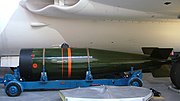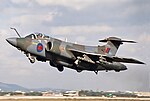The WE.177, originally styled as WE 177, and sometimes simply as WE177, was a series of tactical and strategic nuclear weapons with which the Royal Navy...
35 KB (3,686 words) - 13:21, 29 September 2024
of Glasgow, Scotland. Since the decommissioning of the Royal Air Force WE.177 free-fall thermonuclear weapons during March 1998, the four Vanguard submarines...
27 KB (2,636 words) - 19:43, 18 October 2024
Trident II missiles. Since 1998, when the UK decommissioned its tactical WE.177 bombs, the Trident has been the only operational nuclear weapons system...
189 KB (21,581 words) - 22:55, 19 October 2024
was introduced in 1961, entered service in 1962. It was replaced by the WE.177 in the early 1970s and was withdrawn from service in 1971. Red Beard was...
12 KB (1,451 words) - 15:23, 28 July 2024
Soviet offensive with both conventional and nuclear weapons, namely the WE.177 nuclear bomb, which was retired in 1998. German and Italian Tornados are...
162 KB (17,522 words) - 20:47, 24 October 2024
The Heinkel He 177 Greif (Griffin) was a long-range heavy bomber flown by the Luftwaffe during World War II. The introduction of the He 177 to combat operations...
89 KB (12,297 words) - 09:03, 4 November 2024
Warspite and King George VI. Since the retirement of the last Royal Air Force WE.177 nuclear bomb in 1998, the British nuclear arsenal has been wholly submarine-based...
22 KB (1,890 words) - 17:38, 16 October 2024
reduction in diameter of the WE.177A to 16.5 in (42 cm), the bomb's width and fin span being constrained by the need to fit two WE.177 bombs side-by-side in...
72 KB (9,358 words) - 18:01, 17 October 2024
to replace it in 1961. Beginning in 1966, Yellow Sun was replaced by the WE.177, based on another US design. The casing was around 21 feet (6.4 m) long...
11 KB (1,431 words) - 16:49, 1 November 2024
nuclear weapons delivery in 1965; weapons deployed included Red Beard and WE.177 free-fall bombs, which were carried internally on a rotating bomb-bay door...
66 KB (8,377 words) - 03:25, 7 November 2024









